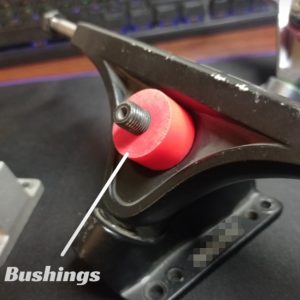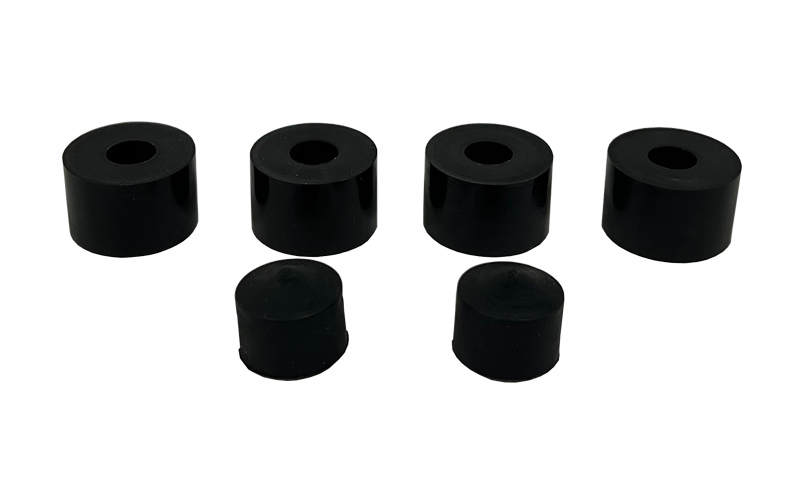When most people think about upgrading their electric skateboard, they immediately look at the motors, the deck, or the wheels. But there’s one component that quietly shapes every turn, carve, and cruise—the bushings.
Whether you’re new to the scene or fine-tuning your setup for maximum performance, understanding what skateboard bushings are, and how to choose the right ones, can completely change your experience..
1. What Are Skateboard Bushings?
The Small Part with a Big Impact
Bushings are those small, donut-shaped urethane pieces that sit inside your trucks. They compress and rebound as you lean, allowing the board to pivot and turn. Think of them as the joints that let your board move with you. Without bushings, your board wouldn’t steer at all.
Though they might look simple, bushings play a key role in how your board handles—affecting everything from carving smoothness to high-speed stability.
No matter what you ride—electric board, cruiser, or longboard—your choice of skateboard bushings matters. Especially for electric riders, where speed and terrain vary fast, the right bushings skateboard setup isn’t optional—it’s essential.

2. How Bushings Shape Your Ride
Bushings directly shape the feel of your ride. Whether you’re carving tight turns, cruising in a straight line, or bombing a hill at high speed, your bushings determine how your board responds to every movement.
The key factors here are durometer (hardness) and shape.
- Softer bushings (lower durometer) are more forgiving. They compress easily, allowing for smoother, tighter turns. Great for low-speed carving, cruising, and lighter riders—but they can feel unstable at higher speeds.
- Harder bushings (higher durometer) offer more resistance. They provide greater stability and control, especially during high-speed runs or when riding aggressively. However, they require more effort to lean and turn.

Bushings also affect how quickly your board returns to center after a turn—that “snappy” feeling. If your bushings are too soft or worn out, your board might feel loose or sluggish when trying to re-center.
For electric skateboarders, where speed is often higher than on regular skateboards, choosing the right bushing setup is critical. Too soft, and your board might wobble at speed. Too stiff, and you’ll feel like you’re fighting the turn.
In short, the right bushings balance comfort and control, letting you ride confidently in your preferred style.
3. Selecting the Right Bushing Durometer
Choosing the right bushing hardness—known as durometer—can dramatically improve how your board feels under your feet. The durometer is measured on the Shore A scale, usually ranging from 78A (soft) to 98A (hard) for skateboard bushings.
Here’s a simple guide to help you match your bushing hardness to your riding style:
| Riding Style | Recommended Durometer | Feel |
| Cruising / Carving | 78A – 85A | Soft, smooth, easy turns |
| All-Around / Commuting | 85A – 90A | Balanced, responsive, stable |
| High-Speed / Downhill | 90A – 98A | Firm, stable, less twitchy |
*Quick tip: Lighter riders tend to prefer softer bushings for easier turns, while heavier riders may need firmer ones for better support and control.
Also, don’t forget that riding terrain matters. If you’re carving tight paths or weaving through city traffic, softer bushings can help. But if you’re riding long distances or hitting top speeds on open roads, harder bushings will give you the control you need.
And remember—you’re not stuck with one setup. Many riders experiment with mixing different durometers (e.g., softer bushing boardside, harder roadside) to fine-tune their feel.
Once you’ve found the right durometer, it’s important to know when your current setup needs a refresh.
4. Upgrading Bushings: When and Why to Replace Your Current Setup

Stock bushings that come with most electric skateboards are often generic and not tailored to your weight, speed, or riding style. Upgrading your bushings is one of the easiest and most cost-effective ways to customize your ride—and it can make a huge difference in both comfort and control.
➢ When should you consider replacing your bushings?
- You feel speed wobbles at higher speeds, especially downhill or during acceleration.
- Turning feels too loose or too stiff, and adjusting your truck tightness doesn’t help.
- You’ve gained or lost weight, and your current setup no longer matches your riding needs.
- You ride more aggressively now (e.g., carving harder, going faster) than when you started.
- The bushings look cracked, overly compressed, or deformed—a clear sign of wear.
➢ Why upgrade?
- Improved stability at speed
- More precise turning and carving
- Better rebound and return-to-center feel
- A ride that’s truly dialed into your body and riding style
You don’t need to overhaul your whole setup to feel a big difference—just swapping out bushings can make your board feel brand new.
5. How to Install Your New Bushings (The Right Way)
Swapping out your bushings is a quick upgrade, but installing them correctly is key to getting the best performance. A poorly seated bushing can throw off your turning, cause uneven wear, or even make your trucks feel weird.
Here’s how to do it right:
➢ What You’ll Need:
- New bushings (usually 2 per truck—top and bottom)
- Skate tool or wrench
- Optional: new washers (flat or cupped)
➢ Step-by-Step Installation:
- Remove the kingpin nut
Use your skate tool or wrench to unscrew the kingpin nut on top of your truck.
- Take off the old bushings and washers
Slide off the hanger, then remove the top and bottom bushings along with the washers.
- Install the new bushings
- Place one bushing on the baseplate (boardside)
- Re-insert the hanger
- Add the second bushing on top (roadside), followed by a washer
- Tighten the kingpin nut
Tighten until the bushings are snug but not squished flat. You should still be able to turn the truck, but without excessive play.
➢ Tips for Best Performance:
- Use cupped washers for more rebound and control, or flat washers for a looser feel.
- Don’t over-tighten. Crushing the bushing kills its rebound and shortens its life.
- If using mixed durometers, put the harder one boardside for more stability, and the softer one roadside for better turn-in.
6. Troubleshooting Common Bushing Issues
Even if you’ve got the perfect bushings installed, things can still go sideways over time. Here’s a quick guide to some of the most common bushing issues electric skateboarders run into—and how to fix them.
➢ Squeaking Sounds When Turning
Cause: Friction between the bushing and the washer or hanger.
Fix:
- Apply a tiny bit of silicone-based lubricant where the bushing meets metal.
- Don’t use oil-based grease—it can degrade urethane over time.
➢ Bushing Feels Too Loose or Too Tight
Cause: Over- or under-tightened kingpin nut, or mismatched bushing hardness.
Fix:
- Adjust the kingpin nut so there’s some resistance, but the truck still turns smoothly.
- Try different durometers if adjusting doesn’t help.
➢ Cracked, Deformed, or Flattened Bushings
Cause: Age, over-compression, or poor-quality material.
Fix:
- Time for a replacement—once bushings lose their rebound, they’re done.
- Consider investing in high-rebound urethane for better durability and feel.
➢ Poor Return-to-Center (Board Doesn’t Self-Correct After Turns)
Cause: Worn-out or overly soft bushings, missing cupped washers.
Fix:
- Swap in firmer bushings boardside or upgrade to higher-rebound options.
- Use cupped washers to add rebound support.
➢ Trucks Feel Unstable at Speed
Cause: Bushings are too soft for your weight or speed.
Fix:
- Upgrade to a higher durometer (e.g., from 85A to 95A).
- Consider mixing duros (firm boardside, soft roadside) for stability + control.
*This is especially true for longboard bushings, which need to handle higher speeds and deeper turns. If your skate bushings aren’t matched to your weight or terrain, wobbles become more common.
Final Tip: A Small Upgrade with a Big Payoff
Bushings wear out gradually—so if your board starts to feel “off” for no clear reason, check your bushings. A quick swap might be all it takes to bring the ride back to life.
At the end of the day, bushings might be small—but they’re one of the most powerful tools you have to tune your ride. Whether you’re cruising city streets or pushing top speed on an e-board, the right setup can give you the control, comfort, and confidence you need.
Try experimenting, trust how it feels under your feet, and don’t be afraid to switch it up. Your board should work for you.
Ready to upgrade?
→ Explore Ecomobl’s bushing kits and find your perfect setup




